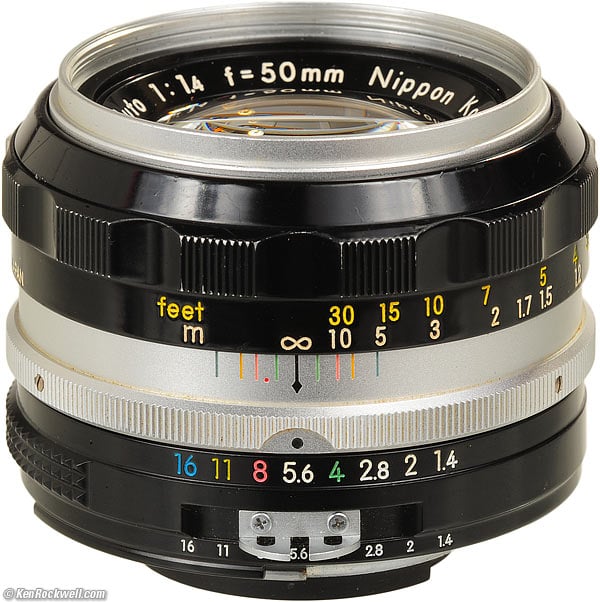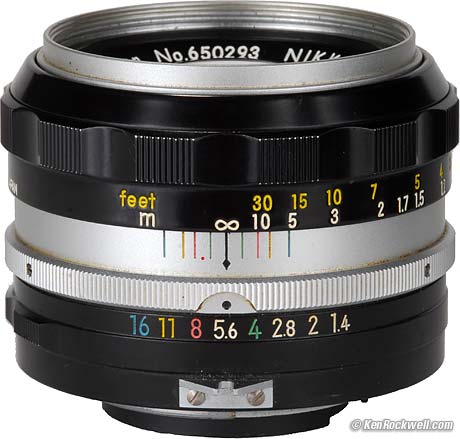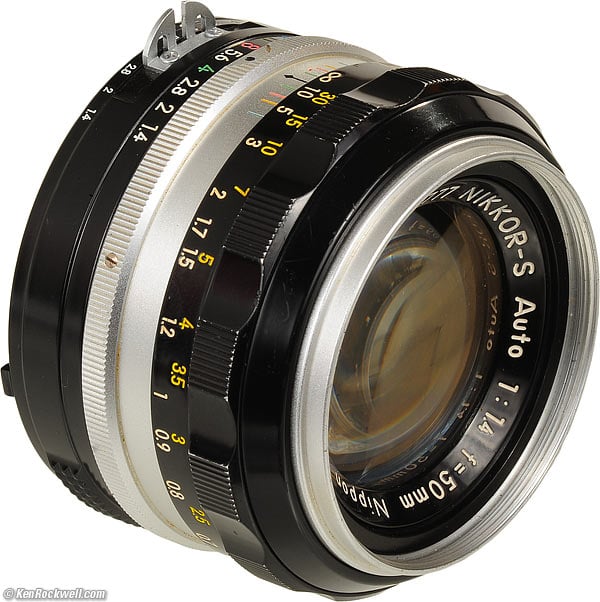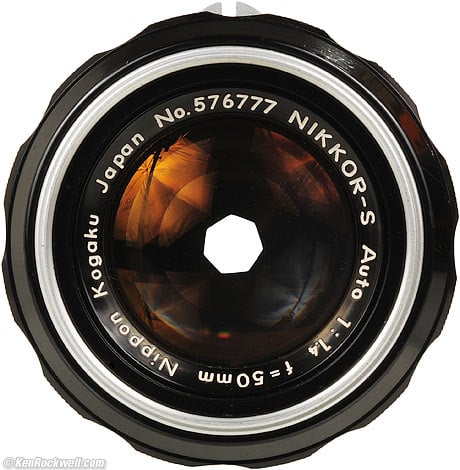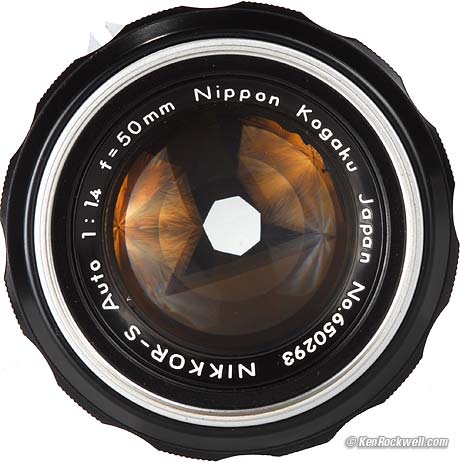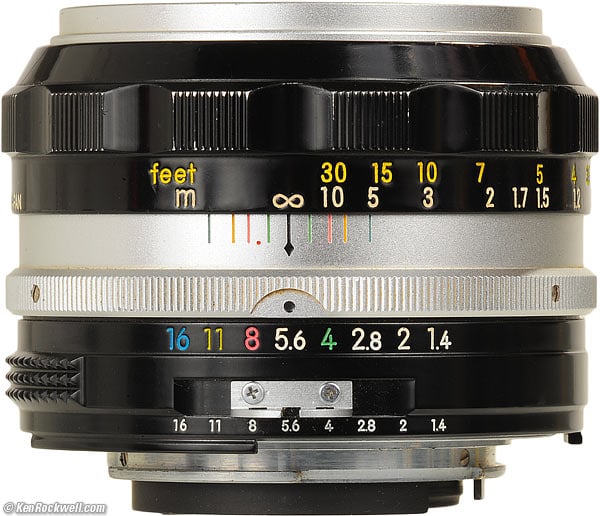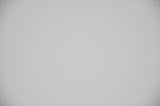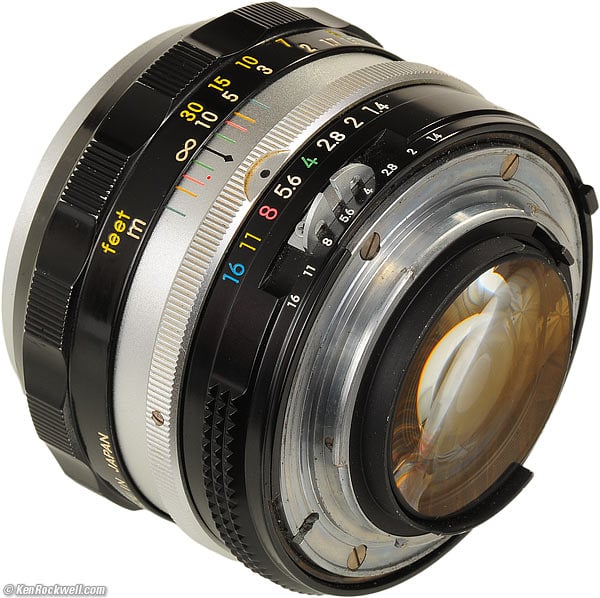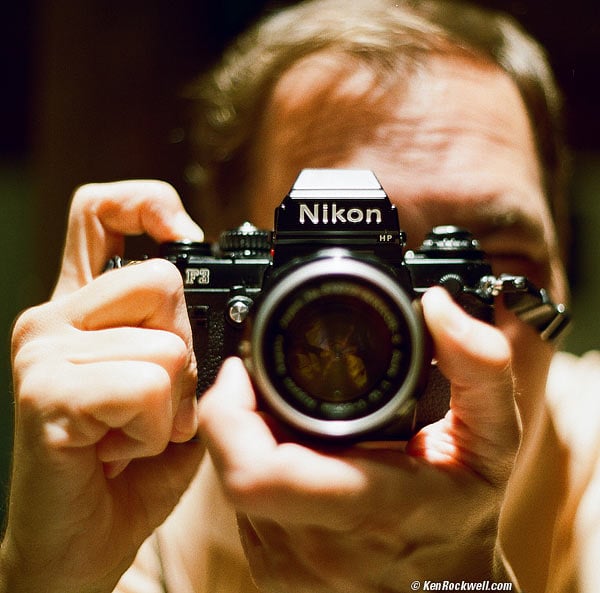Home Donate New Search Gallery Reviews How-To Books Links Workshops About Contact
Nikon 50mm f/1.4
NIKKOR-S Auto (1966-1974)
© 2012 KenRockwell.com. All rights reserved.
Intro Specifications Performance Compared Recommendations
Nikon 50mm f/1.4 NIKKOR-S Auto, AI-updated (this sample from 1967, 52mm filters, 10.8 oz./306g, 2'/0.6m close focus, about $70 used). enlarge. This free website's biggest source of support is when you use any of these links, especially this direct link to this lens at eBay (see How to Win at eBay), when you get anything, regardless of the country in which you live. Thanks! Ken.
May 2013 Nikon Reviews Nikon Lenses All Reviews
Great for
A classic lens that works great on everything from the original Nikon F to today's D4, D800 and D800E.
Not for
No autofocus.
Introduction top
Intro Specifications Performance Compared Recommendations
Compatibility History Production Pricing
|
Adorama pays top dollar for your used gear. I use these stores. I can't vouch for ads below.
|
This Nikon 50mm f/1.4 NIKKOR-S Auto was the world's standard in professional newsgathering during the Apollo era, and still performs great today, with less distortion and far better mechanics than Nikon's newest made-in-China plastic 50mm f/1.4G!
The manual-focus Nikon 50mm f/1.4 NIKKOR-S Auto works great with most Nikon cameras, 35mm and digital.
To work properly with cameras made since 1977, it should have been AI-updated, as was this sample.
Presuming it has been AI-updated, it works flawlessly with every manual focus Nikon ever made, from the original Nikon F of 1959 through the FM3a and today's FM-10.
On the D4, D800, D800E, D3X, D3s, D3, D7000, D700, D300, D200, D2 and F6, use the "Non-CPU Lens Data" menu option to set 50mm and f/1.4 to get full color matrix metering, EXIF data and finder read-out of set aperture. It works great in aperture-preferred as well as manual modes on these cameras.
It works perfectly on every professional 35mm camera (F, F2, F3, F4, F5, F6), and adds Matrix metering on the F6 when programmed into the Non-CPU lens data menu.
The meters of cheaper digital (D90, D5100 and below) and cheaper film cameras (N80 and below) will not couple (or work at all) with this lens, so you'll be on your own guessing exposure using the rear LCD or an external meter, or get a tiny Gossen Digisix meter and hotshoe adapter, or the free Pocket Light Meter app to meter manually.
See Nikon Lens Compatibility for details on your camera. Read down the "AI, AI-s " column for this lens, presuming it's been AI-updated.
If it's still in its original F-mount form, then read the Pre-AI column, and it won't mount on most cameras made since 1977.
Nikon 50mm f/1.4 NIKKOR-S Auto, AI-updated (this sample from 1969). Enlarge.
1950
Nikon invented the world's first 50mm f/1.4 lens in 1950.
1959
Nikon first made a 58mm f/1.4 lens for its new F series SLR cameras for their introduction in 1959.
1962
Nikon's first 50mm f/1.4 SLR lens was a little different than this lens, coming out in 1962.
The optical formulation of lens was introduced in 1966 and made through 1974.
1974
Multicoating was added in 1974.
Later in 1974, a "K" version with rubber grip and slightly different optics was introduced.
1976
A new optical design came out in 1976, which is the version still sold new today.
Nikon made about a million of these 50mm f/1.4 NIKKOR-S lenses from 1966-1974.
They last forever, so they are very easy to find.
Price, new* |
Equivalent with inflation in 2012 |
|
1966 |
$89.50 |
$640 |
2012 |
- |
about $70 used |
*at full NYC discount. Very few people bought their lenses this inexpensively back then.
Nikon 50mm f/1.4 NIKKOR-S Auto. enlarge.
Specifications top
Intro Specifications Performance Compared Recommendations
Name
Nikon calls this the Nippon Kogaku NIKKOR-S Auto 50mm f/1.4.
Nippon Kogaku was Nikon's more formal name for itself.
NIKKOR is Nikon's brand name for their lenses.
-S stands for -sept, or seven, meaning seven lens elements.
Auto means that it has an automatic diaphragm. The diaphragm stops down instantly and automatically from f/1.4 to the taking aperture as the picture is taken, and opens automatically to f/1.4 the instant the image has been captured. We take this for granted today, but it was the hot selling feature back then.
Optics top
7 elements in 5 groups.
Single-coated mostly in amber, optimized for black-and-white film.
As of 1974, it was multicoated, which Nikon calls Nikon Integrated Coating.
Diaphragm top
1967 Nikon 50mm f/1.4 NIKKOR-S Auto at f/5.6. enlarge.
1969 Nikon 50mm f/1.4 NIKKOR-S Auto at f/5.6. Enlarge
7 straight blades. (earlier models were only 6 blades before 1966.)
Stops down to f/16
Aperture Ring top
Yes.
Metal.
Full-stop clicks.
Close Focus top
2 feet.
0.6 meters.
(The multicoated "K" version from 1974-on focuses to 1.45'/0.45m.)
Maximum Reproduction Ratio top
1:9.8.
(The multicoated "K" version from 1974-on focuses to 1:6.8.)
Angle of View top
46° on FX and 35mm.
31° on small-format DX.
Focal Length top
50mm.
On a small-format DX camera, this lens sees an angle-of-view similar to what a 75mm lens would see on a full-frame camera.
Hard Infinity Focus Stop? top
Yes.
This is great for astronomy; just turn to the stop and you have fixed laboratory-perfect focus all night.
Focus Scale top
Yes.
Depth-of-Field Scale top
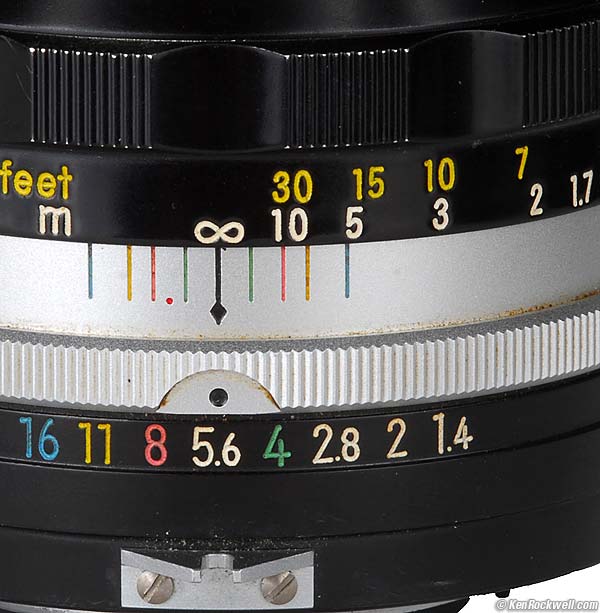
Yes, lines color-coded to apertures.
Infra-Red Focus Index top
Yes: red dot at about f/5.6 in the depth-of-field scale.
Filter Thread top
52mm, solid chromed brass.
Does not rotate.
Size top
Nikon specifies 2.64" (67mm) diameter by 1.87" (47.5mm) extension from flange (2.22"/56.5mm overall).
Weight top
10.805 oz. (306.4g), measured.
Nikon specifies 11.5 oz. (325g).
Hood top
HS-1 metal snap-on.
HN-5 metal screw-in.
Case top
CL-6 brown Corinthian leather tubular case.
Number 51.
CP-1 plastic bubble.
Made in top
Japan.
Teleconverters top
Nikon says the TC-200 and TC-201 work.
Performance top
Intro Specifications Performance Compared Recommendations
Overall Focus Bokeh Color Coma Distortion
Ergonomics Falloff Filters Focus Breathing Ghosts
Color Fringes Mechanics Sharpness Spherochromatism Sunstars
Overall performance top
The 50mm f/1.4 NIKKOR-S Auto performs as expected: flawless, timeless mechanics and optics which are as good or better than today's plastic lenses when stopped down a couple of stops.
Shot at f/1.4 and f/2, it can be a bit less contrasty, but so what; very little is ever in focus at those apertures anyway.
Shooting this classic makes it so obvious that very little has changed optically over the years, with the real changes are purely cosmetic to stimulate sales and to reduce Nikon's costs.
Focus performance top
Focus is dry and as smooth as silk, with very little damping and no play.
Manual focus is flawless, both with a real camera like the Nikon F3, or with the three-way ( " > o < " ) manual focus indicators on newer cameras like the D4, D800, D800E, D3X, D3s, D3, D700, F4, F5, F6 and most professional AF cameras.
Lesser digital cameras, like the D300s and down, usually have just one "OK" focus dot, which is not as precise as two arrows and a dot.
Bokeh performance top
Bokeh, the character of out-of-focus backgrounds, not simply how far out of focus they are, is usually quite pleasant, with both foregrounds and backgrounds melting away with very little distraction.
Katie talking to Noni at Mangia Bene, 03 May 2012. (Nikon F3, f/1.4 at 1/15 hand-held, Kodak Gold 100, NCPS process and scan.) bigger, but know that it's blurry because Katie and Noni are moving and talking and playing at a mile a minute, so at 1/15 hand-held, I'm surprised anything came out!
Color Rendition performance top
The color rendition of this Nikon 50mm f/1.4 NIKKOR-S Auto is a little cooler than my newer multicoated NIKKOR lenses.
This is because its amber coatings are optimized to transmit as much blue light as possible, to which black-and-white film is most sensitive, with somewhat less transmission of red than multicoated lenses.
No big deal, especially on digital cameras whose Auto White Balance nulls it out, and/or whose White Balance settings can be set to add a little more amber, giving you the best of all worlds.
Coma performance top
Coma (saggital coma flare) is weird smeared blobs that appear around bright points of light in the corners. They happen with fast and wide lenses at large apertures. Coma goes away as stopped down, and tends not to be seen in slower and tele lenses. Coma is an artifact of spherical aberration.
As expected for this older design, coma is quite obvious at f/1.4, greatly improved at f/2, and gone by f/2.8.
Distortion performance top
The Nikon 50mm f/1.4 has the usual mild barrel distortion of all Nikon's 50mm f/1.4 SLR lenses.
It has less distortion than the newest 50mm f/1.4G.
It can be corrected by plugging these figures into Photoshop's lens distortion filter. These aren't facts or specifications, they are the results of my research that requires hours of photography and calculations on the resulting data.
FX and Film |
|
10' (3m) |
+1.5 |
Ergonomics performance top
Nikon 50mm f/1.4 NIKKOR-S Auto. enlarge.
This Nikon 50mm f/1.4's ergonomics are perfect!
Focus adjusts with your thumb and forefinger, and the aperture ring adjusts with just the tip of your middle finger as you hold the lens in your left hand. When shooting a real camera, you never need to take these three dedicated fingers off the lens' controls.
You can preset focus and aperture manually by feel, even before you lift the camera to your eye. Just turn to the stop, and with experience, you'll know exactly how far to turn it for different distances, even without looking. This sure beats autofocus, which still requires at least some light to focus.
With twelve precision ribbed, raised areas and matching lands in the solid aluminum focus ring, it's easy to put a finger on one and know exactly where the ring is set by feel, something we lost when Nikon downgraded to cheap rubber-bands for focus rings around 1974.
When shooting with one hand, it's easy to set the aperture or focus with the middle finger of your right hand, especially when put in one of the lands of the rings.
You can't do that with AF lenses because their focus rings usually turn 360,º unlike this lens where each focus distance corresponds to only one unique position of the focus ring.
Likewise, the aperture ring has only one position for each aperture, so it's also trivial to turn it to the stop in the dark, and count clicks to set your aperture without taking your attention away from your subject. You can't do that with AF lenses, since the dopey function buttons and rings spin around and around without stopping, and even worse, you have to take your attention off your subject and look at a display on your camera at the same time.
Falloff (darkened corners) performance top
Falloff on FX is usually visible at f/1.4, greatly reduced at f/2, and gone at f/2.8.
It won't be much of an issue at all on DX (see crop factor).
I've exaggerated this by shooting a gray field and placing these on a gray background:
Nikon 50mm f/1.4 NIKKOR-S Auto falloff on FX and film at infinity, no correction.
© 2012 KenRockwell.com. All rights reserved.
|
Filters, Use with performance top
Vignetting is not a problem, even with stacked filters.
There's no need for expensive "thin" polarizers or grads.
Flare and Ghosts performance top
I don't see any ghosts with reasonable use.
Likewise, I'd expect lower contrast shooting into the light in color with this single-amber-coated lens, but didn't see anything significant.
Focus Breathing performance top
Of interest mostly to cinematographers focusing back and forth between two subjects, the image from the Nikon 50mm f/1.4 S gets larger as focused more closely.
This is a traditional unit-focusing lens. The images grows because the entire optical cell moves forward slightly as focused more closely.
Lateral Color Fringes performance top
When shot on the D800, which automatically corrects lateral color fringes as best it can, the Nikon 50/1.4S has no color fringes, except sometimes for some very slight orange/blue fringes only in the farthest corners.
Spherochromatism is a different aberration, and applies to anything even slightly out of focus.
Mechanics performance top
Nikon 50mm f/1.4 NIKKOR-S Auto. enlarge.
Like all Nikon manual focus NIKKOR lenses, this 50mm f/1.4 NIKKOR-S Auto is built to the highest mechanical standards of any lens ever made.
Even after 45 years with no maintenance, this 1967 lens as tested today in 2012 feels and works better than most of the plastic crap that Nikon wants us to buy instead. God bless Nikon for ensuring that these classic lenses still work perfectly on the newest Nikon DSLRs!
Barrel Exterior
Anodized and enameled aluminum and solid chromed brass.
Filter Threads
Solid chromed brass.
Hood
Black anodized and enameled aluminum.
Focus Ring
Solid metal.
Focus Helicoids
Solid brass: smooth and silky with no play or need for damping grease.
Depth-of-Field Scale
Engraved into barrel and filled with different colors of paint.
Internals
All metal.
Aperture Ring
Solid aluminum.
Engraved markings filled with different colors of paint coded to the depth-of-field scale.
Automatic Aperture-Coupling Prong
Solid chromed, machined brass.
Mount
Dull-chromed brass.
Markings
Engraved into the metal and filled with paint.
Identity and Serial Number
On the front of the lens, inside the filter ring, engraved into the metal and filled with paint.
Moisture Seal at Mount
No.
Noises When Shaken
Mild to moderate clicking and clunking.
Made in
Japan.
Sharpness performance top
Warning 1: Image sharpness depends more on you than your lens.
Warning 2: Lens sharpness doesn't mean much to good photographers.
With those caveats, the 50mm f/1.4 NIKKOR-S Auto is less contrasty at f/1.4, and super-sharp, even on the 36 MP D800, stopped down to f/2.8 and smaller. It's exactly as we expect for a classic 50mm f/1.4.
Used as intended at f/1.4 (low light or isolating a subject), it's brilliant. The focused object is sharp, and all else fades away. In the snap below, only the "Nikon" logo is in focus. It's sharp, and everything else is softer as intended. Even the "F3" insignia is farther away and therefore out-of-focus. Not bad for shooting in a bathroom mirror:
Self Portrait at Mangia Bene, 03 May 2012. (f/1.4 in AUTO, Nikon F3 and 1967 50/1.4 S, Kodak Gold 100.) uglier.
Sharpness o n the 36 MP D800:
At f/1.4
The 50mm f/1.4 NIKKOR-S Auto has less contrast in the center due to spherical aberration, but it's still reasonably sharp. Anything not perfectly in focus will of course be very soft, and overall at f/1.4, we have a dreamier look than the newest 50mm f/1.4G, which is quite sharp and contrasty in the center, even at f/1.4.
Away from the center, coma and everything else quickly degrade sharpness.
The 50/1.4 is softest in the zonal area, the area about 15-18mm away from the center of the image, and then sharpens up a bit at the corners. The corners are loaded with coma at f/1.4, but so what; its unlikely you've got the corners in focus anyway unless you're shooting test charts.
At f/2
The image is significantly better at f/2.
In the center, it's completely sharp and contrasty, even at 36 MP.
The sides are also much better, but still far from perfect.
At f/2.8
Again, a stunning improvement from f/2. Now just about all of the full-frame image is sharp and contrasty except for the last millimeter or so of the far corners.
At f/2.8, this is a very sharp lens overall, especially at 36 MP as I'm testing it.
At f/4
The farthest corners improve a bit at f/4 from f/2.8.
At f/5.6
The corners are now greatly improved.
At f/8
The corners are optimum at f/8.
At f/8, the image is optimum all over, although the central 90% of the image isn't that much different from how it looked at f/2.8.
At f/11 and smaller
Diffraction limits performance at the smallest two apertures.
Spherochromatism performance top
The Nikon 50mm f/1.4 has just a little spherochromatism, meaning that out-of-focus highlights can sometimes take on a little bit of green (background) or magenta (foreground) color fringes.
Sunstars performance top
With its straight 7-bladed diaphragm, the 50mm f/1.4 makes great Nikon-standard 14-pointed sunstars on bright points of light.
Compared top
Intro Specifications Performance Compared Recommendations
See my 50mm Comparison for pages of explicit details and comparisons to modern lenses.
My experience shows that the 50mm f/1.4G will be sharper at f/1.4 and have color balance that matches other modern lenses better, but stopped down, they'll be as sharp. They have similar bokeh, and this NIKKOR-S has less distortion and better sunstars.
Recommendations top
Intro Specifications Performance Compared Recommendations
The Nikon 50mm f/1.4 NIKKOR-S Auto is a marvelous lens for use on any Nikon.
On digital, I'd add an extra unit or two of Amber or Red to the white balance to match newer lenses. Even without that, I get the same brilliant, sharp and colorful results out of this veteran lens as I do with the newest 50mm lenses. Not much changes except cosmetics over the years.
All AF 50mm lenses are made much less well. This Apollo-era classic is made as it should be. If you prefer to shoot with real cameras as I do instead of plastic junk, consider one of these.
Be sure you get one that has been properly updated to AI by changing the aperture ring to the newest type with an original Nikon part. Avoid buying any lens that's had a "hatchet job," where someone sent it out and had the original aperture ring machined to add an AI groove. These are easy to identify by their pasted-on secondary aperture scale.
If you get one with the original F aperture ring, don't send it out to be butchered by a machinist; find the correct AI conversion kit (a new aperture ring) and have it installed professionally.
The Nikon 50mm f/1.4 NIKKOR-S Auto is a manual-focus only lens.
If you've found all the time, effort and expense I incur researching and sharing all this information for free, my biggest source of support is when you use any of these links, especially this direct link to this lens at eBay (see How to Win at eBay), when you get anything, regardless of the country in which you live. Thanks! Ken.
Deployment top
I'd pitch the original Nikon cap that came with this lens new, and get a new "pinch" type cap. I'm not kidding: the new fatter caps are much easier to use in the field.
I'd leave either a 52mm Nikon Clear (NC - UV) filter, or a 52mm Hoya Super HMC UV on the lens at all times. I would leave the hood at home.
If I was working in nasty, dirty areas, I'd forget the cap, and use an uncoated 52mm Tiffen UV filter instead. Uncoated filters are much easier to clean, but more prone to ghosting.
For color prints or slide film like Velvia 50, I use an old Nikon A2 or new 52mm Hoya HMC 81A all the time, except indoors at night, when I simply pull the filter.
For B&W film outdoors, I'd use an old Nikon Y48 or O56, or a new 52mm Hoya HMC K2 Yellow or 52mm Hoya HMC Orange.
Help me help you top
I support my growing family through this website, as crazy as it might seem.
The biggest help is when you use any of these links when you get anything, regardless of the country in which you live. It costs you nothing, and is this site's, and thus my family's, biggest source of support. These places have the best prices and service, which is why I've used them since before this website existed. I recommend them all personally.
If you find this page as helpful as a book you might have had to buy or a workshop you may have had to take, feel free to help me continue helping everyone.
If you've gotten your gear through one of my links or helped otherwise, you're family. It's great people like you who allow me to keep adding to this site full-time. Thanks!
If you haven't helped yet, please do, and consider helping me with a gift of $5.00.
As this page is copyrighted and formally registered, it is unlawful to make copies, especially in the form of printouts for personal use. If you wish to make a printout for personal use, you are granted one-time permission only if you PayPal me $5.00 per printout or part thereof. Thank you!
Thanks for reading!
Mr. & Mrs. Ken Rockwell, Ryan and Katie.
Home Donate New Search Gallery Reviews How-To Books Links Workshops About Contact

